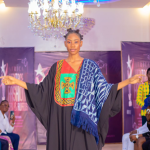What inspired you to create the Autogele?
Oluwafunmilola shares that the inspiration came from a conversation with media mogul Mo Abudu, who suggested creating a ready-to-wear Gele that would allow women to look fabulous without needing a skilled artist. Recognizing the challenge, Oluwafunmilola collaborated with her sister-in-law to develop a prototype, leading to the debut of the Autogele in 2015.
How do you maintain a balance between respecting cultural heritage and adapting it for contemporary audiences?
She emphasizes that her designs are rooted in tradition, especially with the use of Aso-Oke fabric, but adapted with modern mechanisms like fasteners. Oluwafunmilola also diversifies her collection, offering Pleated Autogeles for a traditional look and Iconic Geles for a modern touch, appealing to various preferences within and beyond Africa.
What challenges did you face when introducing the Autogele?
Despite initial positive reception, she encountered impersonation issues online, with someone responding to critiques on her behalf. Nevertheless, acceptance from high-profile figures like Deola Ade-Ojo and Rita Dominic greatly boosted the Autogele’s popularity, illustrating how celebrity endorsement can drive industry trends and acceptance.
How do you respond to critics who claim the Autogele dilutes the art of Gele tying?
Oluwafunmilola argues that the Autogele, although pre-tied, involves meticulous handcrafting to ensure durability and style. For her, the creation’s value in convenience and accessibility, coupled with the economic opportunities it provides, outweighs concerns over the traditional technique’s perceived dilution.
How has the Autogele been received at international fashion events?
The Autogele has graced fashion runways such as the Heineken Lagos Fashion Week and even appeared in American cinema. It’s been embraced globally, illustrating the demand for African fashion items that blend heritage with modern-day convenience.
Can you share some examples of notable public figures who have worn the Autogele?
Notable personalities like Toke Makinwa and Bonang Matheba have worn the Autogele, helping it gain recognition. Their support, often shared on social media, has contributed significantly to the Autogele’s spread and appeal in global markets.
How do you ensure that the Autogele still allows for individuality, even though it’s pretied?
Each Autogele is custom-made based on client preferences. By offering personalized options for colors, fabrics, and styles, Oluwafunmilola ensures that the Autogele allows for individuality and creativity, making it a unique accessory for each wearer.
How do you see the Autogele evolving in the next five years?
She sees the Autogele expanding in global fashion, much like African music and cuisine. Oluwafunmilola believes that the Autogele can complement any attire, much like hats or fascinators, making it a versatile accessory in both African and global wardrobes.
Can you discuss the impact the Autogele has had on the fashion industry, both within Africa and internationally?
By making Gele accessible, the Autogele has created new markets for African fashion, with local artisans producing it for both domestic and international clients. As African fashion becomes more mainstream, the Autogele represents a significant element in promoting and preserving cultural identity globally.
What makes the Autogele special from a design standpoint?
Combining traditional fabrics like Aso-Oke with intricate, sculptural designs, the Autogele serves as a statement piece at formal events. It’s more than an accessory; it’s a symbol of African craftsmanship and an homage to cultural heritage.
How important is the preservation of traditional fabrics in your work, particularly with the Autogele?
For Oluwafunmilola, using traditional fabrics like Aso-Oke ensures that the cultural roots are retained. The Autogele’s success lies in its modern appeal paired with these fabrics, allowing it to celebrate both African history and contemporary fashion.
What does it mean to you to see the Autogele become a global symbol of African pride and fashion?
She views its global popularity as a testament to the growing recognition of African creativity and a reflection of diaspora pride. It shows how African fashion can create meaningful connections across cultures.
Do you have any plans to collaborate with other designers or brands to expand the Autogele’s reach?
She is enthusiastic about partnering with global fashion houses to introduce the Autogele into mainstream fashion, ensuring its authenticity while embracing broader markets. Collaborations with streetwear and couture designers are potential avenues she envisions for furthering the Autogele’s influence.
What advice would you give to upcoming designers who want to innovate within traditional fashion without losing authenticity?
She advises upcoming designers to deeply understand and respect the traditions they work with. By staying true to one’s vision and heritage, designers can create something fresh while honoring the roots of the culture.
How do you envision the Autogele being worn in different contexts—both casual and formal?
While primarily seen as a formal accessory, Oluwafunmilola also sees potential for the Autogele in casual settings, paired with everyday attire like jeans or summer dresses, allowing it to become a staple in a variety of wardrobes.









Comments are closed.